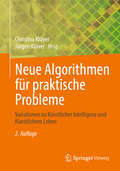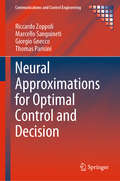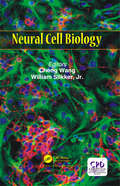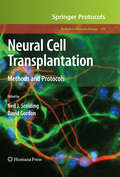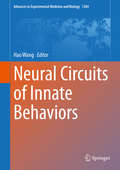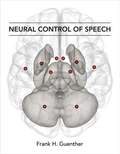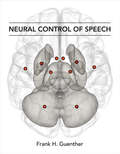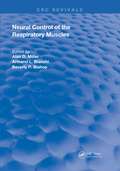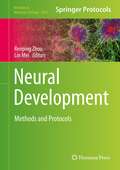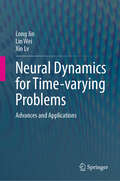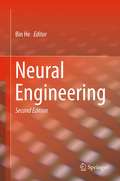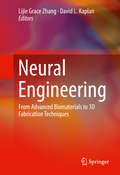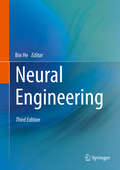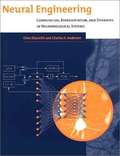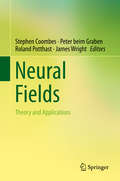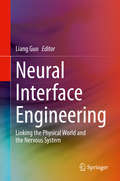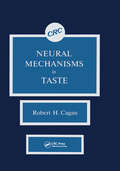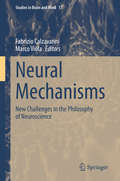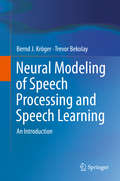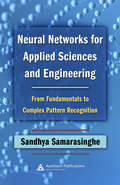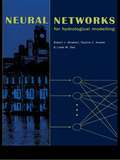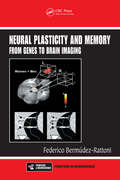- Table View
- List View
Neue Algorithmen für praktische Probleme: Variationen zu Künstlicher Intelligenz und Künstlichem Leben
by Jürgen Klüver Christina KlüverIn diesem Sammelband geht es darum, neue Algorithmen aus den Bereichen der Künstlichen Intelligenz (KI) und des Künstlichen Lebens (KL) und deren praktische Anwendung zu zeigen. Der wesentliche Aspekt des Bandes ist, dass in den Beiträgen exemplarisch gezeigt wird, dass und wie diese neuen Algorithmen auf praktische Probleme in sehr verschiedenen Bereichen erfolgreich eingesetzt werden können: Von der Modellierung betrieblicher Abläufe und des Managements bis zur Entscheidungsunterstützung bei der Wahl der Start- und Landebahn eines Flughafens, von der Analyse von Sensordaten bis zur Überwachung, Auswahl und Optimierung technischer Systeme sowie Alternativen für die Bildverarbeitung.
Neue Fenster in das Universum: Von Hubble-, James-Webb- und anderen Großteleskopen bis zu Gravitationswellendetektoren
by Arnold HanslmeierDie Beobachtungsmöglichkeiten der modernen Astrophysik werden immer zahlreicher. Sie reichen von optischen Teleskopen über Weltraumteleskope im Infraroten bis zu Radioteleskopen und von Gravitationswellendetektoren bis hin zu Neutrinoobservatorien. Während die einen im Weltraum ein Augenmerk auf das Licht werfen, nehmen andere unter Wasser kleinste Teilchen unter die Lupe oder messen Störungen der Raumzeit, die kleiner sind als der Durchmesser eines Protons. Das Buch bietet einen spannenden umfassenden Überblick über unsere technischen Möglichkeiten, das Universum zu erforschen. Als Grundlage für eine Vorlesung in Astronomie bzw. Astrophysik ist es ebenso geeignet wie als Lektüre für naturwissenschaftlich Interessierte.
Neural Approximations for Optimal Control and Decision (Communications and Control Engineering)
by Riccardo Zoppoli Marcello Sanguineti Giorgio Gnecco Thomas ParisiniNeural Approximations for Optimal Control and Decision provides a comprehensive methodology for the approximate solution of functional optimization problems using neural networks and other nonlinear approximators where the use of traditional optimal control tools is prohibited by complicating factors like non-Gaussian noise, strong nonlinearities, large dimension of state and control vectors, etc. Features of the text include: • a general functional optimization framework; • thorough illustration of recent theoretical insights into the approximate solutions of complex functional optimization problems; • comparison of classical and neural-network based methods of approximate solution; • bounds to the errors of approximate solutions; • solution algorithms for optimal control and decision in deterministic or stochastic environments with perfect or imperfect state measurements over a finite or infinite time horizon and with one decision maker or several; • applications of current interest: routing in communications networks, traffic control, water resource management, etc.; and • numerous, numerically detailed examples. The authors’ diverse backgrounds in systems and control theory, approximation theory, machine learning, and operations research lend the book a range of expertise and subject matter appealing to academics and graduate students in any of those disciplines together with computer science and other areas of engineering.
Neural Cell Biology
by Cheng Wang William Slikker Jr.This book delineates how systems biology, pharmacogenomic, and behavioral approaches, as applied to neurodevelopmental toxicology, provide a structure to arrange information in a biological model. The text reviews and discusses approaches that can be used as effective tools to dissect mechanisms underlying pharmacological and toxicological phenomena associated with the exposure to drugs or environmental toxicants during development. The book intends to elaborate functional outcomes of component-to-component relationships using rodent and nonhuman primate in vitro and in vivo models that allow for the directional and quantitative description of the complete organism in response to environmental perturbations. In addition, attention has also been directed to some of the more recent methodologies, including genomics, proteomics and metabolomics, applied in the evolutionary neurobiological field.
Neural Cell Transplantation
by David Gordon Neil J. ScoldingIn the dramatic and rapidly developing field of neural transplantation for CNS repair, the most powerful contributor has been the vital research focusing on stem cells. In Neural Cell Transplantation: Methods and Protocols, leading experts in the field examine tried-and-true laboratory techniques in order to supply scientists with a firm foundation upon which further advancements can be based. Written in the highly successful Methods in Molecular BiologyTM series format, the chapters of this volume include introductions to their respective topics, lists of the necessary materials and reagents, step-by-step, readily reproducible protocols, and Notes sections, which examine tips on troubleshooting and avoiding known pitfalls. Cutting-edge and easy to use, Neural Cell Transplantation: Methods and Protocols provides the most thorough and essential protocols that will allow new generations of neuroscientists to enter and contribute to this uniquely inspiring field.
Neural Circuits of Innate Behaviors (Advances in Experimental Medicine and Biology #1284)
by Hao WangThis book summarizes the latest research findings in the neurocircuitry of innate behaviors, covering major topics such as innate fear, aggression, feeding, reward, social interaction, parental care, spatial navigation, and sleep-wake regulation. For decades, humans have been fascinated by wild animals’ instincts, like the annual two-thousand-mile migration of the monarch butterfly in North American, and the “imprint” behavior of newborn birds. Since these instincts are always displayed in stereotypical patterns in most individuals of a given species, the neural circuits processing such behaviors must be genetically hard-wired in the brain. Recently, with the development of modern techniques, including optogenetics, retrograde and anterograde virus tracing, and in vivo calcium imaging, researchers have been able to determine and dissect the specific neural circuits for many innate behaviors by selectively manipulating well-defined cell types in the brain. This book discusses recent advances in the investigation of the neural-circuit mechanisms underlying innate behaviors.
Neural Control of Speech
by Frank H. GuentherIn this book, Frank Guenther offers a comprehensive, unified account of the neural computations underlying speech production, with an emphasis on speech motor control rather than linguistic content. Guenther focuses on the brain mechanisms responsible for commanding the musculature of the vocal tract to produce articulations that result in an acoustic signal conveying a desired string of syllables. Guenther provides neuroanatomical and neurophysiological descriptions of the primary brain structures involved in speech production, looking particularly at the cerebral cortex and its interactions with the cerebellum and basal ganglia, using basic concepts of control theory (accompanied by nontechnical explanations) to explore the computations performed by these brain regions.Guenther offers a detailed theoretical framework to account for a broad range of both behavioral and neurological data on the production of speech. He discusses such topics as the goals of the neural controller of speech; neural mechanisms involved in producing both short and long utterances; and disorders of the speech system, including apraxia of speech and stuttering. Offering a bridge between the neurological and behavioral literatures on speech production, the book will be a valuable resource for researchers in both fields.
Neural Control of Speech
by Frank H. GuentherA comprehensive and unified account of the neural computations underlying speech production, offering a theoretical framework bridging the behavioral and the neurological literatures. In this book, Frank Guenther offers a comprehensive, unified account of the neural computations underlying speech production, with an emphasis on speech motor control rather than linguistic content. Guenther focuses on the brain mechanisms responsible for commanding the musculature of the vocal tract to produce articulations that result in an acoustic signal conveying a desired string of syllables. Guenther provides neuroanatomical and neurophysiological descriptions of the primary brain structures involved in speech production, looking particularly at the cerebral cortex and its interactions with the cerebellum and basal ganglia, using basic concepts of control theory (accompanied by nontechnical explanations) to explore the computations performed by these brain regions. Guenther offers a detailed theoretical framework to account for a broad range of both behavioral and neurological data on the production of speech. He discusses such topics as the goals of the neural controller of speech; neural mechanisms involved in producing both short and long utterances; and disorders of the speech system, including apraxia of speech and stuttering. Offering a bridge between the neurological and behavioral literatures on speech production, the book will be a valuable resource for researchers in both fields.
Neural Control of the Respiratory Muscles (Routledge Revivals)
by Alan D. Miller Armand L. Bianchi Beverly P. BishopFirst published in 1997. The respiratory muscles are multifunctional muscles involved in other behaviors besides breathing -- from the protection of the upper airway to cognitive functions such as speech or singing. Neural Control of the Respiratory Muscles presents an overall consideration of how these muscles are regulated by the central nervous system in normal as well as in pathological situations.A group of 40 internationally recognized scientists and clinicians have collaborated to discuss current findings in the field and to identify areas of future development such aso The anatomical and functional organization of the respiratory muscles and the mechanics of the chest wallo Respiratory muscle control by the central nervous system during normal breathing and during disease stateso Respiration during sleep, exercise, and locomotiono Respiratory muscle contribution to non-respiratory behaviors; interaction of the central pattern generator for respiration with other central pattern generatorso Multifunctional nature of respiratory muscles and respiratory neurons of the central nervous systemAlthough other texts exist that examine the control of breathing and other specialized topics considered in this volume, Neural Control of the Respiratory Muscles is the first major single-volume publication that takes a broad view of muscle control during non-respiratory behaviors and the coordination of respiration with non-respiratory behaviors.
Neural Development
by Lin Mei Renping ZhouUnderstanding the molecular and cellular mechanisms underlying the development of specific neural circuits is not just an intellectual curiosity but also central to our ability to develop therapeutic approaches to repair damaged pathways in the future. In Neural Development: Methods and Protocols, experts in the field contribute commonly used protocols to facilitate future research in developmental neuroscience. Split into four convenient sections, this detailed volume covers techniques of culturing neurons and glia as well as their growth and differentiation, methods of gene delivery and down regulation, protocols for analyzing axon growth and guidance plus synapse formation, and, finally, basic methods to analyze brain morphology and axon pathways in developing animals. Written in the highly successful Methods in Molecular Biology series format, chapters include introductions to their respective topics, lists of the necessary materials and reagents, step-by-step, readily reproducible laboratory protocols, and tips on troubleshooting and avoiding known pitfalls. Comprehensive and accessible, Neural Development: Methods and Protocols provides key guidance for students and postdoctoral fellows new to developmental neurobiology.
Neural Dynamics for Time-varying Problems: Advances and Applications
by Long Jin Lin Wei Xin LvThis book mainly presents methods based on neural dynamics for the time-varying problems with applications, together with the corresponding theoretical analysis, simulative examples, and physical experiments. Based on these methods, their applications include motion planning of redundant manipulators, filter design, winner-take-all operation, multiple-input multiple-output system configuration, multi-linear tensor equation solving, and manipulability optimization are also presented. In this book, we present the design, proposal, development, analysis, modeling, and simulation of various neural dynamic models, along with their respective applications including motion planning of redundant manipulators, filter design, winner-take-all operation, multiple-input multiple-output system configuration, multi-linear tensor equation solving, and manipulability optimization. Specifically, starting from the top-level considerations of hardware implementation, we integrate computational intelligence methods and control theory to design a series of dynamic and noise-resistant discrete neural dynamic methods. The research work not only owns the theoretical guarantee on its convergence, noise resistance, and accuracy, but demonstrate the effectiveness and robustness in solving various optimization and equation solving problems, particularly in handling time-varying problems and noise perturbations. Moreover, by reducing complexity and avoiding matrix inversion operations, the models’ feasibility and practicality are further enhanced.
Neural Engineering
by Bin HeNeural Engineering, 2nd Edition, contains reviews and discussions of contemporary and relevant topics by leading investigators in the field. It is intended to serve as a textbook at the graduate and advanced undergraduate level in a bioengineering curriculum. This principles and applications approach to neural engineering is essential reading for all academics, biomedical engineers, neuroscientists, neurophysiologists, and industry professionals wishing to take advantage of the latest and greatest in this emerging field.
Neural Engineering
by Lijie Grace Grace Zhang David L. L. KaplanThis book covers the principles of advanced 3D fabrication techniques, stem cells and biomaterials for neural engineering. Renowned contributors cover topics such as neural tissue regeneration, peripheral and central nervous system repair, brain-machine interfaces and in vitro nervous system modeling. Within these areas, focus remains on exciting and emerging technologies such as highly developed neuroprostheses and the communication channels between the brain and prostheses, enabling technologies that are beneficial for development of therapeutic interventions, advanced fabrication techniques such as 3D bioprinting, photolithography, microfluidics, and subtractive fabrication, and the engineering of implantable neural grafts. There is a strong focus on stem cells and 3D bioprinting technologies throughout the book, including working with embryonic, fetal, neonatal, and adult stem cells and a variety of sophisticated 3D bioprinting methods for neural engineering applications. There is also a strong focus on biomaterials, including various conductive biomaterials and biomimetic nanomaterials such as carbon-based nanomaterials and engineered 3D nanofibrous scaffolds for neural tissue regeneration. Finally, two chapters on in vitro nervous system models are also included, which cover this topic in the context of studying physiology and pathology of the human nervous system, and for use in drug discovery research. This is an essential book for biomedical engineers, neuroscientists, neurophysiologists, and industry professionals.
Neural Engineering (Bioelectric Engineering Ser.)
by Bin HeThis third edition overviews the essential contemporary topics of neuroengineering, from basic principles to the state-of-the-art, and is written by leading scholars in the field. The book covers neural bioelectrical measurements and sensors, EEG signal processing, brain-computer interfaces, implantable and transcranial neuromodulation, peripheral neural interfacing, neuroimaging, neural modelling, neural circuits and system identification, retinal bioengineering and prosthetics, and neural tissue engineering. Each chapter is followed by homework questions intended for classroom use. This is an ideal textbook for students at the graduate and advanced undergraduate level as well as academics, biomedical engineers, neuroscientists, neurophysiologists, and industry professionals seeking to learn the latest developments in this emerging field.Advance Praise for Neural Engineering, 3rd Edition: “A comprehensive and timely contribution to the ever growing field of neural engineering. Bin He’s edited volume provides chapters that cover both the fundamentals and state-of-the-art developments by the world’s leading neural engineers." Dr. Paul Sajda, Department of Biomedical Engineering, Electrical Engineering and Radiology, Columbia University“Neural Engineering, edited by Prof. He, is an outstanding book for students entering into this fast evolving field as well as experienced researchers. Its didactic and comprehensive style, with each chapter authored by leading scientific authorities, provides the ultimate reference for the field.”Dr. Dario Farina, Department of Bioengineering, Imperial College London, London, UK "Neural Engineering has come of age. Major advances have made possible prosthesis for the blind,mind control for quadraplegics and direct intervention to control seizures in epilepsy patients. Neural Engineering brings together reviews by leading researchers in this flourishing field. Dr. Terrence Sejnowski, Salk Institute for Biolgical Studies and UC San Diego
Neural Engineering: Computation, Representation, and Dynamics in Neurobiological Systems
by Chris Eliasmith Charles H. AndersonFor years, researchers have used the theoretical tools of engineering to understand neural systems, but much of this work has been conducted in relative isolation. In Neural Engineering, Chris Eliasmith and Charles Anderson provide a synthesis of the disparate approaches current in computational neuroscience, incorporating ideas from neural coding, neural computation, physiology, communications theory, control theory, dynamics, and probability theory. This synthesis, they argue, enables novel theoretical and practical insights into the functioning of neural systems. Such insights are pertinent to experimental and computational neuroscientists and to engineers, physicists, and computer scientists interested in how their quantitative tools relate to the brain. The authors present three principles of neural engineering based on the representation of signals by neural ensembles, transformations of these representations through neuronal coupling weights, and the integration of control theory and neural dynamics. Through detailed examples and in-depth discussion, they make the case that these guiding principles constitute a useful theory for generating large-scale models of neurobiological function. A software package written in MatLab for use with their methodology, as well as examples, course notes, exercises, documentation, and other material, are available on the Web.
Neural Fields
by James Wright Stephen Coombes Peter Beim Graben Roland PotthastNeural field theory has a long-standing tradition in the mathematical and computational neurosciences. Beginning almost 50 years ago with seminal work by Griffiths and culminating in the 1970ties with the models of Wilson and Cowan, Nunez and Amari, this important research area experienced a renaissance during the 1990ties by the groups of Ermentrout, Robinson, Bressloff, Wright and Haken. Since then, much progress has been made in both, the development of mathematical and numerical techniques and in physiological refinement und understanding. In contrast to large-scale neural network models described by huge connectivity matrices that are computationally expensive in numerical simulations, neural field models described by connectivity kernels allow for analytical treatment by means of methods from functional analysis. Thus, a number of rigorous results on the existence of bump and wave solutions or on inverse kernel construction problems are nowadays available. Moreover, neural fields provide an important interface for the coupling of neural activity to experimentally observable data, such as the electroencephalogram (EEG) or functional magnetic resonance imaging (fMRI). And finally, neural fields over rather abstract feature spaces, also called dynamic fields, found successful applications in the cognitive sciences and in robotics. Up to now, research results in neural field theory have been disseminated across a number of distinct journals from mathematics, computational neuroscience, biophysics, cognitive science and others. There is no comprehensive collection of results or reviews available yet. With our proposed book Neural Field Theory, we aim at filling this gap in the market. We received consent from some of the leading scientists in the field, who are willing to write contributions for the book, among them are two of the founding-fathers of neural field theory: Shun-ichi Amari and Jack Cowan.
Neural Interface Engineering: Linking the Physical World and the Nervous System
by Liang GuoThis book provides a comprehensive reference to major neural interfacing technologies used to transmit signals between the physical world and the nervous system for repairing, restoring and even augmenting body functions. The authors discuss the classic approaches for neural interfacing, the major challenges encountered, and recent, emerging techniques to mitigate these challenges for better chronic performances. Readers will benefit from this book’s unprecedented scope and depth of coverage on the technology of neural interfaces, the most critical component in any type of neural prostheses.Provides comprehensive coverage of major neural interfacing technologies;Reviews and discusses both classic and latest, emerging topics;Includes classification of technologies to provide an easy grasp of research and trends in the field.
Neural Interface: Frontiers and Applications (Advances in Experimental Medicine and Biology #1101)
by Xiaoxiang ZhengThis book focuses on the frontiers of neural interface technology, including hardware, software, neural decoding and encoding, control systems, and system integration. It also discusses applications for neuroprosthetics, neural diseases and neurorobotics, and the toolkits for basic neuroscience. A neural interface establishes a direct communication channel with the central or peripheral nervous system (CNS or PNS), and enables the nervous system to interact directly with the external devices. Recent advances in neuroscience and engineering are speeding up neural interface technology, paving the way for assisting, augmenting, repairing or restoring sensorimotor and other cognitive functions impaired due to neurological disease or trauma, and so improving the quality of life of those affected. Neural interfaces are now being explored in applications as diverse as rehabilitation, accessibility, gaming, education, recreation, robotics and human enhancement. Neural interfaces also represent a powerful tool to address fundamental questions in neuroscience. Recent decades have witnessed tremendous advances in the field, with a huge impact not only in the development of neuroprosthetics, but also in our basic understanding of brain function. Neural interface technology can be seen as a bridge across the traditional engineering and basic neuroscience. This book provides researchers, graduate and upper undergraduate students from a wide range of disciplines with a cutting-edge and comprehensive summary of neural interface engineering research.
Neural Machines: A Defense of Non-Representationalism in Cognitive Neuroscience (Studies in Brain and Mind #22)
by Matej KohárIn this book, Matej Kohar demonstrates how the new mechanistic account of explanation can be used to support a non-representationalist view of explanations in cognitive neuroscience, and therefore can bring new conceptual tools to the non-representationalist arsenal. Kohar focuses on the explanatory relevance of representational content in constitutive mechanistic explanations typical in cognitive neuroscience. The work significantly contributes to two areas of literature: 1) the debate between representationalism and non-representationalism, and 2) the literature on mechanistic explanation.Kohar begins with an introduction to the mechanistic theory of explanation, focusing on the analysis of mechanistic constitution as the basis of explanatory relevance in constitutive mechanistic explanation. He argues that any viable analysis of representational contents implies that content is not constitutively relevant to cognitive phenomena. The author also addresses objections against his argument and concludes with an examination of the consequences of his account for both traditional cognitive neuroscience and non-representationalist alternatives. This book is of interest to readers in philosophy of mind, cognitive science and neuroscience.
Neural Mechanisms in Taste
by Robert H. CaganThe purpose of NEURAL MECHANISM in TASTE is to emphasize physiological principles and reveal new insights of this most recent research. This book is aimed to reach scientists within the broad area of neurophysiology as well as those in other disciplines who have interests in sensory mechanisms. The focus is on two major themes--peripheral mechanisms and neural processing at the central level. Every chapter is written by an expert on the subject matter, including definitive updates on the status of each topic. This work is not only useful to researchers in taste, but also to basic and applied scientists in related fields (such as food technology), doctoral and postdoctoral students.
Neural Mechanisms: New Challenges in the Philosophy of Neuroscience (Studies in Brain and Mind #17)
by Fabrizio Calzavarini Marco ViolaThis volume brings together new papers advancing contemporary debates in foundational, conceptual, and methodological issues in cognitive neuroscience. The different perspectives presented in each chapter have previously been discussed between the authors, as the volume builds on the experience of Neural Mechanisms (NM) Online – webinar series on the philosophy of neuroscience organized by the editors of this volume. The contributed chapters pertain to five core areas in current philosophy of neuroscience. It surveys the novel forms of explanation (and prediction) developed in cognitive neuroscience, and looks at new concepts, methods and techniques used in the field. The book also highlights the metaphysical challenges raised by recent neuroscience and demonstrates the relation between neuroscience and mechanistic philosophy. Finally, the book dives into the issue of neural computations and representations. Assembling contributions from leading philosophers of neuroscience, this work draws upon the expertise of both established scholars and promising early career researchers.
Neural Modeling of Speech Processing and Speech Learning: An Introduction
by Bernd J. Kröger Trevor BekolayThis book explores the processes of spoken language production and perception from a neurobiological perspective. After presenting the basics of speech processing and speech acquisition, a neurobiologically-inspired and computer-implemented neural model is described, which simulates the neural processes of speech processing and speech acquisition. This book is an introduction to the field and aimed at students and scientists in neuroscience, computer science, medicine, psychology and linguistics.
Neural Networks for Applied Sciences and Engineering: From Fundamentals to Complex Pattern Recognition
by Sandhya SamarasingheIn response to the exponentially increasing need to analyze vast amounts of data, Neural Networks for Applied Sciences and Engineering: From Fundamentals to Complex Pattern Recognition provides scientists with a simple but systematic introduction to neural networks. Beginning with an introductory discussion on the role of neural networks in
Neural Networks for Hydrological Modeling
by Linda M. See Pauline E. Kneale Robert J. AbrahartA new approach to the fast-developing world of neural hydrological modelling, this book is essential reading for academics and researchers in the fields of water sciences, civil engineering, hydrology and physical geography. Each chapter has been written by one or more eminent experts working in various fields of hydrological modelling. The b
Neural Plasticity and Memory: From Genes to Brain Imaging
by Federico Bermúdez-RattoniA comprehensive, multidisciplinary review, Neural Plasticity and Memory: From Genes to Brain Imaging provides an in-depth, up-to-date analysis of the study of the neurobiology of memory. Leading specialists share their scientific experience in the field, covering a wide range of topics where molecular, genetic, behavioral, and brain imaging techniq
